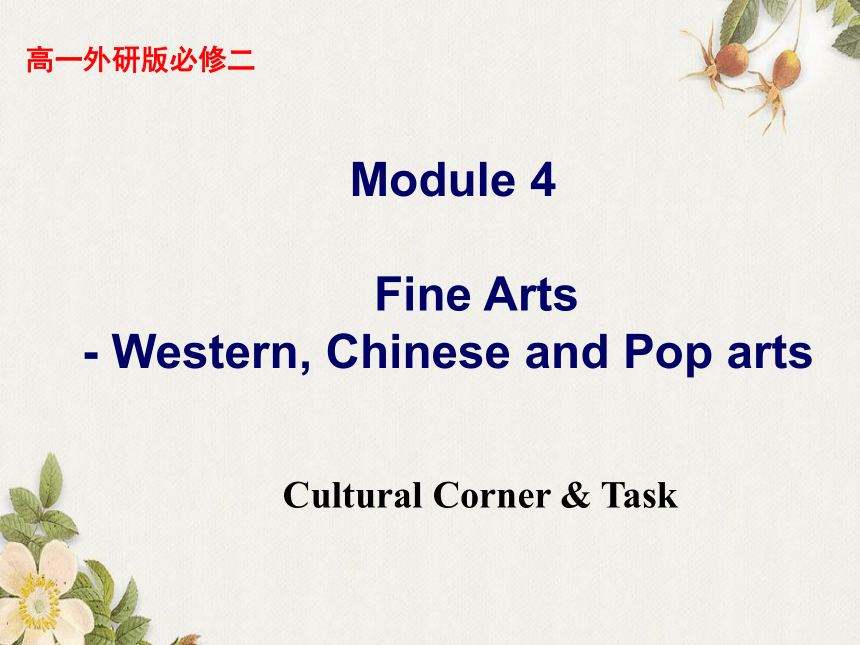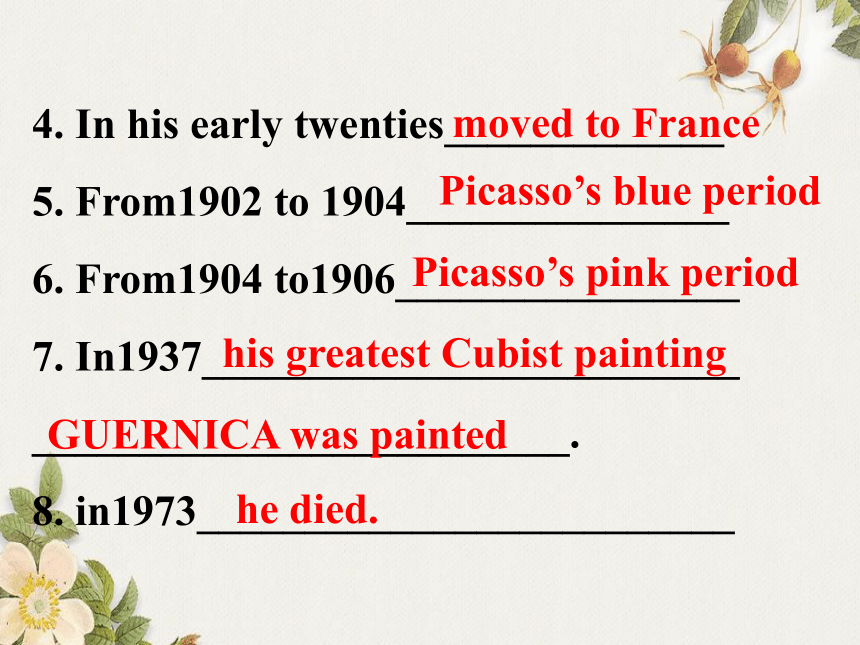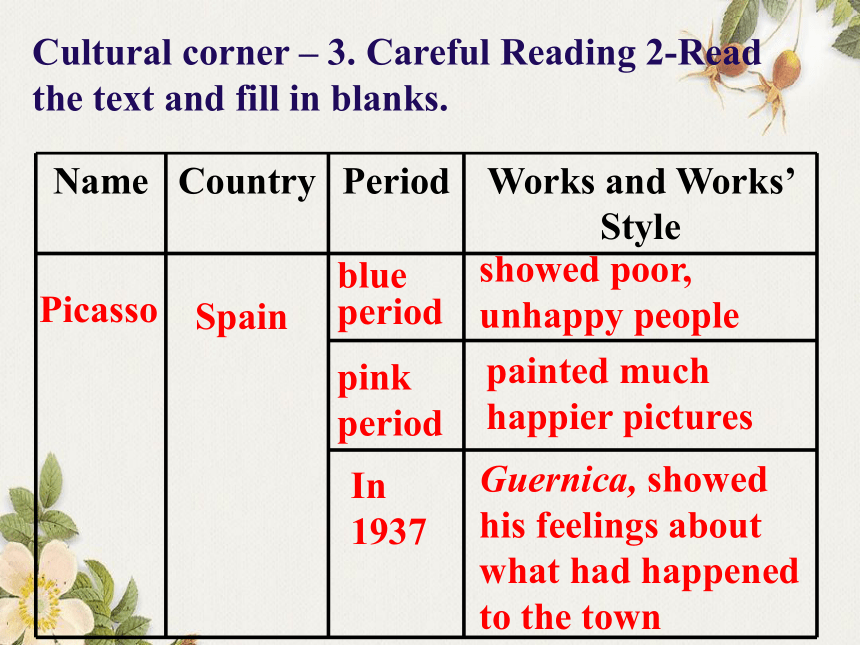外研版高中必修二Module4 Fine Arts – Western, Chinese and Pop Arts cultural corner(共26张)
文档属性
| 名称 | 外研版高中必修二Module4 Fine Arts – Western, Chinese and Pop Arts cultural corner(共26张) |  | |
| 格式 | zip | ||
| 文件大小 | 1020.0KB | ||
| 资源类型 | 教案 | ||
| 版本资源 | 外研版 | ||
| 科目 | 英语 | ||
| 更新时间 | 2021-07-14 20:26:24 | ||
图片预览









文档简介
(共26张PPT)
Module
4
Fine
Arts
-
Western,
Chinese
and
Pop
arts
Cultural
Corner
&
Task
高一外研版必修二
Cultural
Corner
Cultural
corner
–
1.
Warming
up
1-Tell
what
you
have
known.
What
do
you
know
about
Pablo
Picasso
and
his
paintings?
What
have
we
learnt
about
in
reading
and
vocabulary
and
what
are
we
going
to
learn
in
Cultral
Corner:
1.
Picasso’s
blue
period
2.
Picasso’s
pink
period
3.
Picasso
and
Cubism
Cultural
corner
–
1.
Warming
up-2
Read
the
text
and
answer
the
following
questions
Cultural
corner
–
2.
Fast
Reading
Read
the
text
and
guess
in
which
period
were
the
following
pictures
painted.
Blue
period
pink
period
Cultural
corner
–
3.
Careful
Reading
1-
Read
the
text
and
write
down
the
facts
about
Picasso
according
to
the
time
clues
1.
In
1881
_________________________
2.
At
the
age
of
ten__________________
_______________.
3.
At
the
age
of
16
___________________
he
was
born
in
Spain.
he
was
already
an
his
first
exhibition.
excellent
artist
4.
In
his
early
twenties_____________
5.
From1902
to
1904_______________
6.
From1904
to1906________________
7.
In1937_________________________
_________________________.
8.
in1973_________________________
moved
to
France
Picasso’s
blue
period
Picasso’s
pink
period
his
greatest
Cubist
painting
he
died.
GUERNICA
was
painted
Name
Country
Period
Works
and
Works’
Style
Cultural
corner
–
3.
Careful
Reading
2-Read
the
text
and
fill
in
blanks.
Picasso
Spain
blue
period
showed
poor,
unhappy
people
pink
period
painted
much
happier
pictures
In
1937
Guernica,
showed
his
feelings
about
what
had
happened
to
the
town
Language
Points
Picasso
studied
art
in
Spain,
but
moved
to
France,
in
his
early
twenties.
年龄表示法
(1).
表示某人几岁的确切年龄,用“基数词
+years
old”或“基数词+of
age”或者“at
the
age
of+基数词”,也可直接用基数词。
如:孩子们通常7岁开始上学。
Children
usually
start
school
at
(the
age
of)
seven.
她70岁了。
She’s
thirty
years
old.=
She’s
thirty
years
of
age.
(2).
表示某人几十多岁这样的大约年龄,用“in
one’s+基数词的复数(如tens,
twenties,
thirties
等)”来表达。如:
他30多岁时去了美国。
He
went
to
America
in
his
thirties.
他在五十岁出头、接近六十岁时开始有规律的进行体育锻炼。
He
started
to
take
regular
exercise
in
his
early/
late
fifties.
(3).
表示年代
表示在某个世纪的几十年代,用“in
the
+基数词的复数”。基数词的复数若用阿拉伯数字表示,可直接加
s,也可加’s。如
“在20世纪80年代”
是
in
the
1980’s或
in
the
1980s,读作
in
the
nineteen
eighties。注意:不要漏掉
the。
这条铁路建于20世纪70年代。
The
railway
was
built
in
the
1970s.
2.
From
1902
to
1904
he
painted
a
series
of
pictures
where
the
main
color
was
blue.
a
series
of
一系列,一连串
如:厂方的态度可能会引起一系列的罢工。
The
management’s
attitude
may
spark
off
a
series
of
strikes.
宇航员在太空期间将进行一系列的实验。
Astronauts
will
carry
out
a
series
of
tests
while
they
are
in
space.
3.
People
agreed
that
Picasso’s
greatest
Cubist
painting
is
Guernica,
which
was
painted
in
Madrid
in
1937.
agree
vt.
&
vi.
(1)
单独使用,表示同意、答应等。
①
如:我请求他帮忙,他答应了。
I
asked
him
to
help
me
and
he
agreed.
②
经过了短暂的讨论,这项计划大家都同意了。
After
a
short
time
of
discussion,
the
program
was
agreed.
(2)
跟介词with连用.
表示“同意;赞成”;
“与……一致;(气候,食物)
适合”。
例如:
①
我很同意你说的。
I
quite
agree
with
what
you
said.
②
我不太同意他所说的话。
I
don’t
quite
agree
with
what
he
said.
③
动词在人称和数上应与主语一致。
The
verb
must
agree
with
the
subject
in
person
and
number.
④
敌军将领意见不一致,争吵了一整夜。
The
enemy
generals
could
not
agree
with
one
another
and
they
quarreled
the
whole
night.
(3)
跟介同to连用,表示
“
同意;赞成
(表示
提议、安排、计划等的名词)”。例如:
①
我同意这个提议(计划)。
I
agree
to
the
proposal
(the
plan).
②
赞成这个安排吗?
Do
you
agree
to
this
arrangement?
③
我很同意他们的建议。
I
quite
agree
to
their
suggestions.
(4)
与介词on连用,表示“对……取得一致
意见”(主语往往是协商一件事的人们或单
位,后面常接表示具体协议的文件、计
划、行动等名词)。例如:
①
下次会议的日期达成了一致的协议。
The
date
for
the
next
meeting
was
agreed
on.
②
他们一致同意第二天到那里去。
They
agreed
on
going
there
the
following
day.
(5)
跟不定式作宾语,表示“同意做某事”。
例如:①
他同意找人来帮我们的忙。
He
agreed
to
get
someone
to
help
us.
②
她同意在我到来之前把一切都准备好。
She
agreed
to
get
everything
ready
before
I
come.
(6)
跟从句,表示“一致认为、同意”。
例如:大多数科学家一致认为,计算机不能完全代替人。
Most
scientists
agreed
that
computers
cannot
completely
take
the
place
of
human
beings.
Task
Prepare
a
class
questionnaire
on
students’
likes
and
dislikes
in
arts
1.
What
kind
of
art
do
you
know?
2.
Which
kind
of
art
do
you
like
most?
Why?
3.
Why
don’t
you
like
other
forms
of
arts?
4.
Do
you
usually
go
to
the
art
galleries?
5.
How
long
do
you
usually
spent
your
time
on
art
activities?
Group
work
Now
work
in
groups
of
six.
Ask
the
questions
and
write
down
the
answers.
You
may
want
to
ask
them
to
say
something
more
about
each
question.
Writing
Write
a
paragraph
about
each
opinion.
Write
a
short
paragraph
about
your
opinion.
3.
Show
your
report
to
other
students
in
the
class.
Homework
Students
in
our
country
have
very
little
access
to
all
forms
of
arts.
But,
in
fact,
arts
can
have
an
good
effect
on
them.
Try
to
write
a
letter
to
give
some
advice
on
how
to
develop
the
art
education
of
the
students
and
what
art
forms
do
you
think
are
useful
to
the
students.
How
can
they
be
useful
to
the
students.
Module
4
Fine
Arts
-
Western,
Chinese
and
Pop
arts
Cultural
Corner
&
Task
高一外研版必修二
Cultural
Corner
Cultural
corner
–
1.
Warming
up
1-Tell
what
you
have
known.
What
do
you
know
about
Pablo
Picasso
and
his
paintings?
What
have
we
learnt
about
in
reading
and
vocabulary
and
what
are
we
going
to
learn
in
Cultral
Corner:
1.
Picasso’s
blue
period
2.
Picasso’s
pink
period
3.
Picasso
and
Cubism
Cultural
corner
–
1.
Warming
up-2
Read
the
text
and
answer
the
following
questions
Cultural
corner
–
2.
Fast
Reading
Read
the
text
and
guess
in
which
period
were
the
following
pictures
painted.
Blue
period
pink
period
Cultural
corner
–
3.
Careful
Reading
1-
Read
the
text
and
write
down
the
facts
about
Picasso
according
to
the
time
clues
1.
In
1881
_________________________
2.
At
the
age
of
ten__________________
_______________.
3.
At
the
age
of
16
___________________
he
was
born
in
Spain.
he
was
already
an
his
first
exhibition.
excellent
artist
4.
In
his
early
twenties_____________
5.
From1902
to
1904_______________
6.
From1904
to1906________________
7.
In1937_________________________
_________________________.
8.
in1973_________________________
moved
to
France
Picasso’s
blue
period
Picasso’s
pink
period
his
greatest
Cubist
painting
he
died.
GUERNICA
was
painted
Name
Country
Period
Works
and
Works’
Style
Cultural
corner
–
3.
Careful
Reading
2-Read
the
text
and
fill
in
blanks.
Picasso
Spain
blue
period
showed
poor,
unhappy
people
pink
period
painted
much
happier
pictures
In
1937
Guernica,
showed
his
feelings
about
what
had
happened
to
the
town
Language
Points
Picasso
studied
art
in
Spain,
but
moved
to
France,
in
his
early
twenties.
年龄表示法
(1).
表示某人几岁的确切年龄,用“基数词
+years
old”或“基数词+of
age”或者“at
the
age
of+基数词”,也可直接用基数词。
如:孩子们通常7岁开始上学。
Children
usually
start
school
at
(the
age
of)
seven.
她70岁了。
She’s
thirty
years
old.=
She’s
thirty
years
of
age.
(2).
表示某人几十多岁这样的大约年龄,用“in
one’s+基数词的复数(如tens,
twenties,
thirties
等)”来表达。如:
他30多岁时去了美国。
He
went
to
America
in
his
thirties.
他在五十岁出头、接近六十岁时开始有规律的进行体育锻炼。
He
started
to
take
regular
exercise
in
his
early/
late
fifties.
(3).
表示年代
表示在某个世纪的几十年代,用“in
the
+基数词的复数”。基数词的复数若用阿拉伯数字表示,可直接加
s,也可加’s。如
“在20世纪80年代”
是
in
the
1980’s或
in
the
1980s,读作
in
the
nineteen
eighties。注意:不要漏掉
the。
这条铁路建于20世纪70年代。
The
railway
was
built
in
the
1970s.
2.
From
1902
to
1904
he
painted
a
series
of
pictures
where
the
main
color
was
blue.
a
series
of
一系列,一连串
如:厂方的态度可能会引起一系列的罢工。
The
management’s
attitude
may
spark
off
a
series
of
strikes.
宇航员在太空期间将进行一系列的实验。
Astronauts
will
carry
out
a
series
of
tests
while
they
are
in
space.
3.
People
agreed
that
Picasso’s
greatest
Cubist
painting
is
Guernica,
which
was
painted
in
Madrid
in
1937.
agree
vt.
&
vi.
(1)
单独使用,表示同意、答应等。
①
如:我请求他帮忙,他答应了。
I
asked
him
to
help
me
and
he
agreed.
②
经过了短暂的讨论,这项计划大家都同意了。
After
a
short
time
of
discussion,
the
program
was
agreed.
(2)
跟介词with连用.
表示“同意;赞成”;
“与……一致;(气候,食物)
适合”。
例如:
①
我很同意你说的。
I
quite
agree
with
what
you
said.
②
我不太同意他所说的话。
I
don’t
quite
agree
with
what
he
said.
③
动词在人称和数上应与主语一致。
The
verb
must
agree
with
the
subject
in
person
and
number.
④
敌军将领意见不一致,争吵了一整夜。
The
enemy
generals
could
not
agree
with
one
another
and
they
quarreled
the
whole
night.
(3)
跟介同to连用,表示
“
同意;赞成
(表示
提议、安排、计划等的名词)”。例如:
①
我同意这个提议(计划)。
I
agree
to
the
proposal
(the
plan).
②
赞成这个安排吗?
Do
you
agree
to
this
arrangement?
③
我很同意他们的建议。
I
quite
agree
to
their
suggestions.
(4)
与介词on连用,表示“对……取得一致
意见”(主语往往是协商一件事的人们或单
位,后面常接表示具体协议的文件、计
划、行动等名词)。例如:
①
下次会议的日期达成了一致的协议。
The
date
for
the
next
meeting
was
agreed
on.
②
他们一致同意第二天到那里去。
They
agreed
on
going
there
the
following
day.
(5)
跟不定式作宾语,表示“同意做某事”。
例如:①
他同意找人来帮我们的忙。
He
agreed
to
get
someone
to
help
us.
②
她同意在我到来之前把一切都准备好。
She
agreed
to
get
everything
ready
before
I
come.
(6)
跟从句,表示“一致认为、同意”。
例如:大多数科学家一致认为,计算机不能完全代替人。
Most
scientists
agreed
that
computers
cannot
completely
take
the
place
of
human
beings.
Task
Prepare
a
class
questionnaire
on
students’
likes
and
dislikes
in
arts
1.
What
kind
of
art
do
you
know?
2.
Which
kind
of
art
do
you
like
most?
Why?
3.
Why
don’t
you
like
other
forms
of
arts?
4.
Do
you
usually
go
to
the
art
galleries?
5.
How
long
do
you
usually
spent
your
time
on
art
activities?
Group
work
Now
work
in
groups
of
six.
Ask
the
questions
and
write
down
the
answers.
You
may
want
to
ask
them
to
say
something
more
about
each
question.
Writing
Write
a
paragraph
about
each
opinion.
Write
a
short
paragraph
about
your
opinion.
3.
Show
your
report
to
other
students
in
the
class.
Homework
Students
in
our
country
have
very
little
access
to
all
forms
of
arts.
But,
in
fact,
arts
can
have
an
good
effect
on
them.
Try
to
write
a
letter
to
give
some
advice
on
how
to
develop
the
art
education
of
the
students
and
what
art
forms
do
you
think
are
useful
to
the
students.
How
can
they
be
useful
to
the
students.
